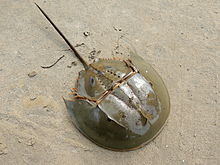Tachypleus gigas
| Tachypleus gigas | |
|---|---|

| |
| Female, off the Bay of Bengal | |
| Scientific classification | |
| Domain: | Eukaryota |
| Kingdom: | Animalia |
| Phylum: | Arthropoda |
| Subphylum: | Chelicerata |
| Order: | Xiphosura |
| Family: | Limulidae |
| Genus: | Tachypleus |
| Species: | T. gigas
|
| Binomial name | |
| Tachypleus gigas (Müller, 1785)
| |
| Synonyms[2] | |
| |
Tachypleus gigas, commonly known as the Indo-Pacific horseshoe crab,
Description

It grows up to about 50 cm (20 in) long, including the tail, and is covered by a sturdy carapace that is up to about 26.5 cm (10.4 in) wide.[7]
Tachypleus gigas has a
Despite the scientific name T. gigas, the close relative
Sexual difference
Like the other species, females of T. gigas grow larger than males. On average in Sarawak, Malaysia, females are about 42 cm (17 in) long, including a tail that is about 20 cm (7.9 in), and their carapace (prosoma) is about 22 cm (8.7 in) wide. In comparison, the average for males is about 34 cm (13 in) long, including a tail that is about 17.5 cm (6.9 in), and their carapace is about 17.5 cm (6.9 in) wide.[7] There are some geographic variations in the average size, but most are similar to, or somewhat smaller, than the ones from Sarawak. An outlier are individuals from West Bengal in India where the average carapace width only is about 17 cm (6.7 in) and 14 cm (5.5 in) in females and males respectively.[9] The largest females of the species reach a total length of more than 50 cm (20 in) and can weigh more than 1.8 kg (4.0 lb).[7]
In addition to their smaller size, males have a paler and rougher carapace, act as hosts to a greater number of epibionts,[8] have six (instead of three) long spines on either side of the rear carapace, and their two front pairs of walking legs, prosomal appendages two and three, have hooks (they are scissor-like in females).[6] Juveniles (both sexes) also have six long spines on either side of the rear carapace, similar to adult males.[6]
Distribution and habitat


Tachypleus gigas is one of three living species of horseshoe crabs in Asia, the others being Tachypleus tridentatus and Carcinoscorpius rotundicauda. The fourth living species,
Tachypleus gigas inhabits
Breeding
The
Ecology
The diet of T. gigas is chiefly composed of molluscs, detritus, and polychaetes, which it seeks on the ocean floor.[21] House crows have been observed to turn T. gigas over and eat the soft underside, while gulls only attack individuals that are already stranded upside-down.[3]
Since horseshoe crabs do not moult after they have reached sexual maturity, they are often colonised by
Conservation
Tachypleus gigas is listed as
Taxonomy
Tachypleus gigas was
Tachypleus gigas is estimated to have
References
- ^ . Retrieved 20 November 2021.
- ^ a b c d e S. Lazarus; V. Narayana Pillai; P. Devadoss & G. Mohanraj (1990). "Occurrence of king crab, Tachypleus gigas (Muller), off the northeast coast of India" (PDF). Proceedings of the First Workshop on Scientific Results of FORV Sagar Sampada, 5–7 June 1989, Kochi: 393–395.
- ^ ISBN 978-0-674-01159-5.
- ISBN 978-0-674-01159-5.
- ISBN 978-0-306-46681-6.
- ^ a b c "Identification guide". Horseshoe Crab monitoring site. Retrieved 26 June 2018.
- ^ a b c A. Raman Noor Jawahir; Mohamad Samsur; Mohd L. Shabdin; Khairul-Adha A. Rahim (2017). "Morphometric allometry of horseshoe crab, Tachypleus gigas at west part of Sarawak waters, Borneo, East Malaysia". AACL Bioflux. 10 (1): 18–24.
- ^ .
- ^ ISBN 978-0-387-89959-6.
- ^ ISBN 978-9971-69-150-9.
- ^ "COAST / Horseshoe crabs" (PDF). Project Oceanography. University of South Florida. 2001. pp. 81–91.
- ^ a b "About the Species". The Horseshoe Crab. Retrieved 26 June 2018.
- ^ Liza Carruthers. "Horseshoe crab". The Internet Encyclopedia of Science. Retrieved January 22, 2011.
- ^ "Tachypleus gigas (Müller, 1785)". Horseshoe Crab monitoring site. Retrieved 26 June 2018.
- ^ .
- ^ a b Tan, Ria (November 2019). "Coastal horseshoe crab". Wild Singapore. Retrieved 17 January 2023.
- ISBN 978-0-674-01159-5.
- JSTOR 2408025.
- ISBN 978-0-387-89959-6.
- JSTOR 1541959.
- .
- ISBN 978-1-58829-046-5.
- PMID 12116485.
- ISBN 978-0-674-01159-5.

